Veronica flowers are considered herbaceous annuals or perennials, however there is wide debate among botanists and horticulturalists about whether the genus Hebe should be included within the wider genus of Veronicas.
The Veronica plant is the largest genus within the Plantaginaceae family with around 500 species.
If we include Hebe, then Veronica would also include subshrubs, shrubs, and small trees. Veronica’s distribution is quite wide, it’s generally considered that its main distribution is within the Northern Hemisphere but is also spread across the Southern Hemisphere somewhat as well.
It’s likely the name ‘Veronica’ came from the plants connection with Saint Veronica, the name was chosen by Carl Linnaeus based on the preexisting usage of veronica which goes as far back as 1572.
Some species within the genre worth noting are Parahebe, Hebe, and Veronicastrum
Veronica has a wide array of uses in food and hermetic medicine, Veronica’s rounded stems should set it apart from other herbs. Some compare the taste of veronica to that of watercress and similar herbs.
Within horticulture the genus is used as ground cover, to protect topsoil from the elements and over watering. However, for our purposes, Veronicas, even though they are treated as weed by some, actually have some really sought after inflorescence.
Many people cultivate Veronicas as purely ornamental flowers which is the main thing we are interested in here. Read on to learn how you can utilise Veronicas as ornamental flowers within your own garden and flower displays.
1. Veronica Austriaca Subsp. Teucrium ‘Crater Lake Blue’
Within the genus there can be a lot of differentiation with inflorescence. Your common Veronica generally flowers in panicales that can be compared to Lavender heads, however they are less dense also.
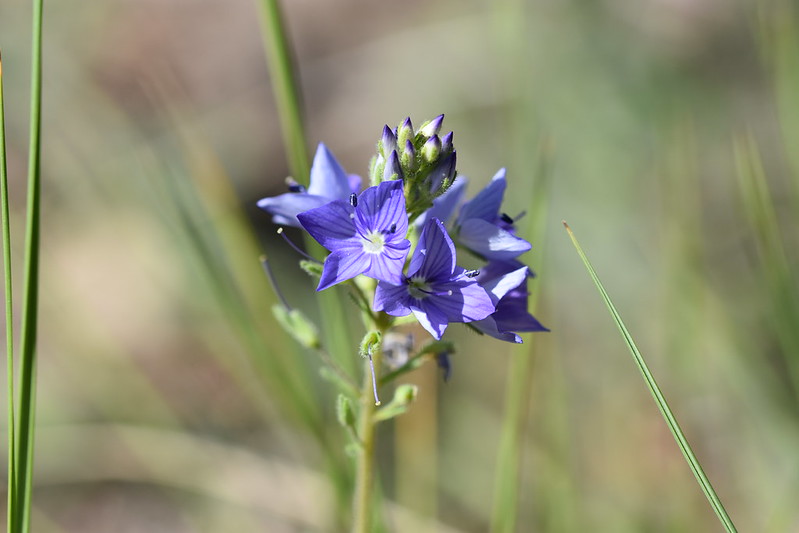
Sometimes the panicles are made from pinnate petals, and sometimes they are made from the more commonly recognised petals.
In general, the genus enjoys wet areas and cool summers. This is great for some climates such as Europe where the summers aren’t too hot but rainfall can be great.
This is also good for the home gardener as you don’t have to worry about over watering, rather you should worry about the climate being too dry. This makes them perfect to grow outside and in beds or borders which can be more damp.
‘Austriaca’ means ‘of Austria’ where the plant’s endemic climate is. Try to mimic this climate for optimal growth and flowering.
This specific cultivar has panicles of cobalt blue flowers among the lush evergreen foliage. A great way to contrast the greens and browns of the surrounding area with the bold blue colors of this cultivar. Even in the wild these really catch the eye and stand out.
2. Veronica Spicata ‘Glory’
As mentioned inflorescence can really differ depending on the species and cultivation. With this Veronica cultivar we see the longer spike or panicle inflorescence of the Veronica. The branching flowers can reach 12 inches when optimised for growth.
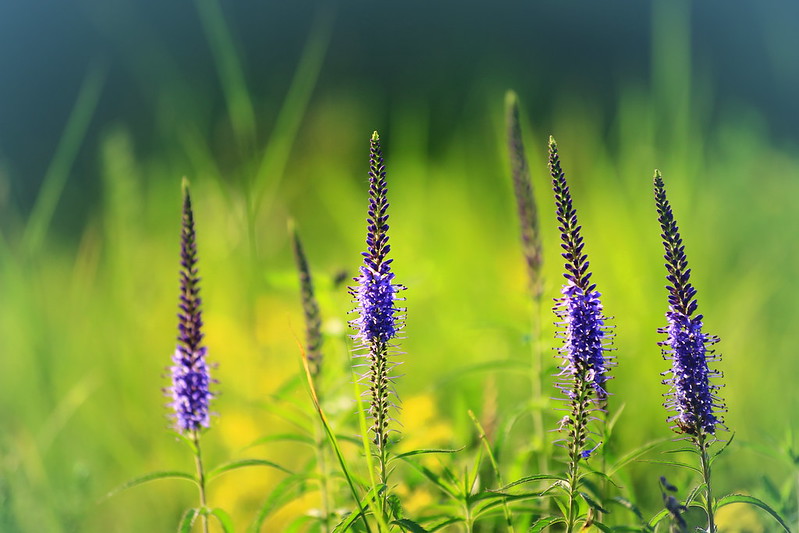
This neat but bushy cultivar has long but deep sapphire flowers that have a lime green tip, they could easily be mistaken for lavender but the deep blue and shades of purple can set it apart from other species and cultivars.
When mature they are sight to behold and would look great among other Lamiales or genera such as Lupinus. Another great thing about Veronicas is that they can flower into the deep fall from June to October so are great for beds at the end of the season.
3. Veronica Longfolia ‘Marietta’
This is very similar to the ‘Glory’ cultivar, however it has a few points of difference that could make it preferential to the latter cultivar.

The main similarity is the inflorescence which is similar to panicles of long flowers and also has a seriously deep purple color, slightly deeper and more purple than ‘Glory’.
Both are absolute magnets for bees and other insects, which is desirable in a garden.
What makes this specific cultivar worth noting is that, if deadheaded, they can last a really long time. Their flowering season, when grown in optimal conditions and maintained well, can be as long as June to November.
This is great for those who want a show bed nearer the end of the season and potentially into winter.
4. Veronica Longifolia ‘Charming Pink’
This cultivar is of the same morphology and species as ‘Marietta’, logifolia. But this particular cultivar really delivers in terms of its name. The color is an elegant sugary pink that is certainly charming.

The inflorescence is the same as the previous, long panicles of flowers with extruding stamens.
In combination with some of the purple Veronica cultivars, it could make for a very charming bed indeed. Similarly to its sister cultivar ‘Marietta’ these can have a very long flowering period if grown in optimal conditions: wet soil that doesn’t dry out and not too much heat.
Related: 23 Different Types Of Veronica Plants (Including Photos)
5. Veronicastrum Virginica ‘Album’
This is one for the American gardeners. As we mentioned, there can be a lot of debate of what should be classed within the genera of ‘Veronica’, the Veronicastrum is debated, but we think is worth mentioning when walking about inflorescence.
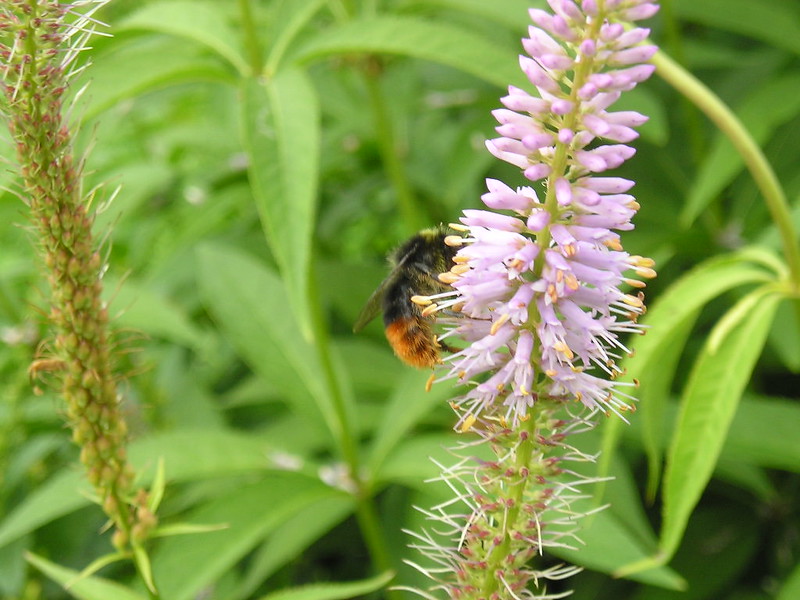
Moreover, Veronicastrum virginicum is a subspecies endemic to North America, so will grow well in American gardens.
The inflorescence of the Veronicastrum is somewhere in between a Hebe and a Veronica. They have spires of long stamens that are wrapped in a petal, the stamens protrude gracefully once the petals fall.
With this particular cultivar the stamens have an elegantly white body with some bronzed tips.
The combination of colors and the morphology makes for an elegant alternative to the classic Veronica. These species also have a similarly long flowering time like Veronicas, the particular cultivar can flower until September.
6. Veronicastrum Virginicum ‘Erica’
Another Veronicastrum is endemic to North America. This cultivar boasts some much darker colors than the previous cultivar. Reddish, rose colored spires rise high into the sky and are a great compliment to this cultivar of much darker foliage.
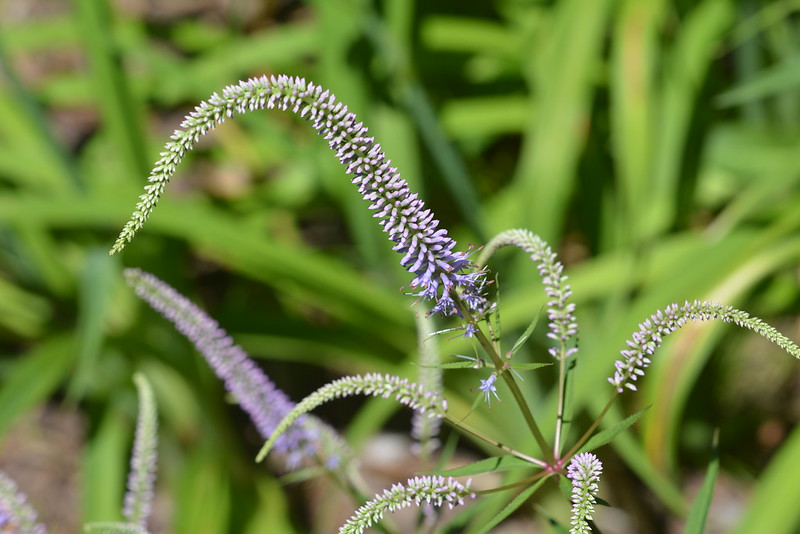
Of all Veronicastrum, this is the one that has the strongest red or pink color so could be worth considering. This has an equally long flowering period.
7. Hebe Albicans ‘Red Edge’
As previously mentioned, there is a wide botanical debate about whether Hebe should be included in the genus of Veronica, we think it’s still worth mentioning when discussing inflorescence.
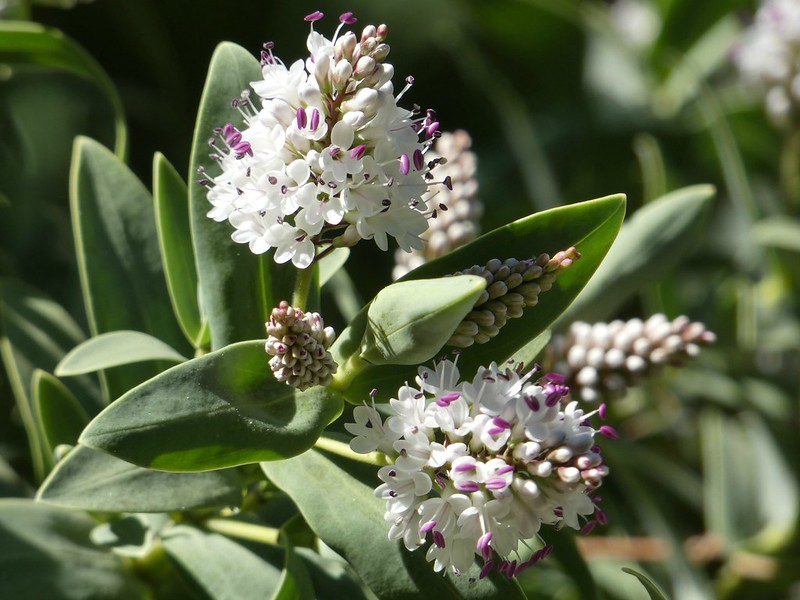
The main point of difference with the Hebe in comparison to the Veronica and Veronicastrum is that its leaves and stems are a little more succulent that the standard veronica.
While technically a shrub it’s pretty low growing and wouldn’t look amiss among other Veronica species.
In general, Hebes are very low maintenance but are still rewarding. Like Veronicas they enjoy wet soil and are a good choice for coastal gardens as they deal well with the salt-laden air.
Again, much like the Veronica the flowers will hang around until late fall if treated properly. When in bloom the evergreen shrub has a whie to lilac flowering spike that has a distinct red edge, hence the name.
These are a great way to add some variation into a Veronica bed, as well as some curiosity.
8. Hebe ‘Green Globe’
This is another cultivar worth looking at, even when out of the flowering periods the bright green foliage is more than enough to catch the attention of a passer-by.
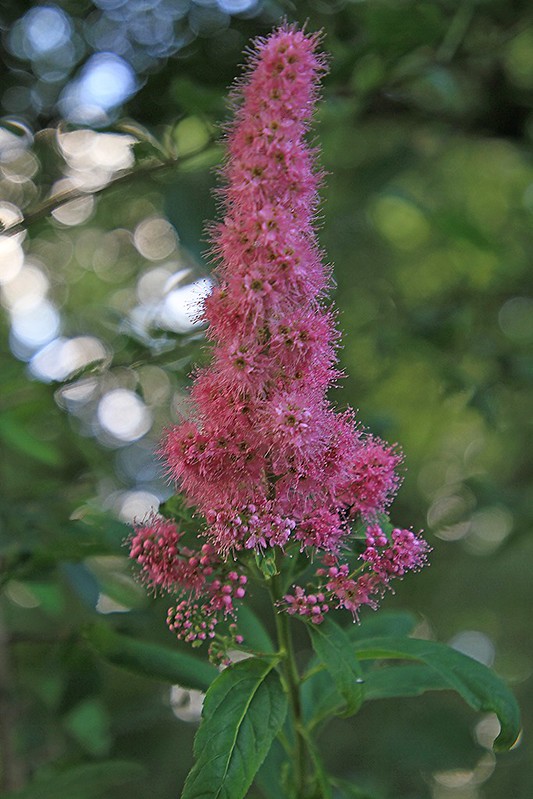
Another great thing about the Hebe is that the morphology of the leaf is so neat that it seems as if it has been pruned when in actual fact the leaves grow naturally tidy like this making it a very low maintenance shrub.
Moreover Hebe’s are generally quite hardy. The foliage alone is super cool, and would look great among other showy foliage such as a Heuchera.
Although in the flowering season they do produce small white flowers that emerge from the bright green foliage.
The combination is truly beautiful and will catch the eye of any gardener or passer-by. In addition, like other Veronicas, bees love Hebe and will help pollinate your garden.
The Final Say
So there you go, Veronica is a widely debated genus that is already pretty enormous in terms of subspecies, but some feel that Veronicastrum, Hebe and other similar species should be subsumed under the Veronica genus.
Hopefully we have provided enough examples that you can make your own decision but we think it’s simply a botanical debate and does not detract anything from each species.
All these species are great simply because of their long flowering time ensuring that you get the most out of your plants and their flowers. The bees will love that they flower for so long too.
One way you can celebrate all of these individual species is to create a ‘Veronica’ bed (purposeful use of inverted commas in order to avoid botanical outrage).
Within this bed you can put all these cultivars and each species’ differences can complement one another.
Bring round an enthusiastic botanist and you can debate the topic of Veronicas in the summer sun while admiring your Veronic show bed.
Editor’s Recommendations
Top 10 Weeds With Purple Flowers (And How To Get Rid Of Them?)
20 Pretty Purple Plants (Including Pictures)
65 Stunning Purple Flowers of Different Types (Including Pictures)







